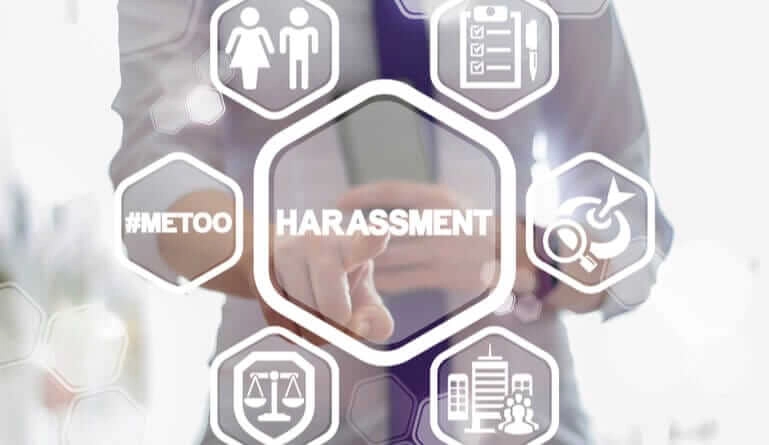Creating a comfortable workplace environment that is safe and non-threatening should be a priority for every business. When employees feel secure, this will contribute to their productivity and will benefit the company as a whole. One way to achieve this is to minimize incidents of harassment and violence in the workplace.
What constitutes workplace harassment and violence?
Workplace harassment and violence can take many different forms of unacceptable behavior that may or may not be easily identifiable. These acts can be physical, psychological, and/or sexual. They can happen as one-off incidents or can be a systematic pattern of behavior between colleagues, superiors and subordinates, or with/by third-parties.
Workplace harassment examples
When an individual is deliberately and repeatedly threatened, abused and/or humiliated in situations associated with work, this can be considered harassment. Some examples of harassment include offending speech, sexual advances, inappropriate sexual gestures, verbal abuse, spreading malicious rumors, racial, religious or gender slurs, and other offending acts. Harassment is also sometimes referred to as bullying and can happen face-to-face, by phone, email, letter, or through other forms of communication.
Examples of workplace violence
Workplace violence examples include physical intimidation, physical threats and attacks, assault, destroying property, and other threatening acts. Workplace violence often takes place in the physical work environment, traveling to and from work, while attending work-related functions, while using work-provided devices, or in company-provided accommodations.
12 Tips for Workplace Violence and Harassment Prevention
Many countries in America and Europe have laws that consider forms of workplace violence and harassment illegal. However, according to findings from CARE International UK, one-third of countries globally do not have any laws to address harassment at work. This has prompted a number of major business groups to propose an initiative that pushes for a global law that will end workplace violence and harassment.
While laws and regulations are designed to penalize offenders, prevention is still a better cure to stop these abuses from taking place. Here are some tips on how HR professionals and managers can create a workplace culture free from harassment and violence.
1. Create clear policies and guidelines
Many incidents of workplace violence and harassment happen because of ignorance. While there are, of course, deliberate acts, there are also people who are unaware or clueless that their actions fall under these unacceptable behaviors.
It is then very important for companies to formulate a clear set of guidelines that specify and illustrate what types of behavior will not be tolerated in the workplace or in workplace-related events. Having these policies in black and white will help prevent misunderstandings and confusion.
2. Communicate policies effectively
Once you complete drafting your policies, it is not enough that you hand these out or email them to employees. You have to ensure that each line item is communicated and understood by them.
Conducting workplace violence training and harassment awareness orientation are traditional methods done by employers, however, many companies perform training just to protect themselves from legal implications. At times, instead of helping, these sessions become awkward and many employees make fun of them.
Make sure that in communicating policies, be sensitive and take the subject seriously. At the end of the training, request employees to provide an acknowledgment that they understand the policies.
3. Conduct bystander training
Many cases of workplace violence and harassment go unreported. This is because many people are scared that their complaints may backfire on them. One way to avoid this from happening is by conducting bystander training wherein people who may not necessarily be involved in an incident are empowered to report assault or harassment that they have witnessed.
4. Introduce activities to improve company culture
Improving workplace culture is possibly the most effective way to prevent harassment and violence. When people work in an environment that values mutual respect, equality, and professionalism, this could reduce incidents of abusive and offending behavior.
It is not easy to instantly change the company culture, but you can start by introducing activities that will make the workplace less toxic and stressful. If you have the budget for it, a paid company outing or out-of-town team building seminars will, of course, be helpful. However, these activities do not need to take so much time, money or effort.
For example, changing your company’s strict policy on coffee breaks is one way to give your employees more time to relax as well as develop a sense of community and trust. According to studies, office coffee breaks can help increase productivity and lessen stress, which can contribute to a less toxic workplace environment.
5. Make changes in the office design
Many cases of harassment and violence take place in private and enclosed spaces. By making physical changes in office design, such incidents could potentially be reduced.
Using transparent materials like glass or plexiglass for interior walls of private offices is one way to achieve visual transparency, while still maintaining acoustical privacy. Another way is to eliminate areas where employees may feel trapped or cornered. For example, common rooms like break rooms, storage spaces, or copy rooms should have two exit points. This will allow employees to have an easy escape in case of unwanted behavior.
6. Install security cameras and access control systems
Having security cameras can help a business secure its assets but at the same time, it could also deter employees from doing unacceptable behavior. If they know that there are cameras recording their moves 24/7, there is a lesser chance of committing an offense. Security cameras can also help employees feel more secure in the workplace environment.
It is also important to control the people who come in and out of the office. Adding an access control system gives an added layer of security to the people working inside. This can also prevent incidents of third-party violence and harassment.
7. Make personal data confidential
There are instances wherein harassment and bullying do not stop inside the workplace. Reports of people being continually harassed and abused even when they are already in their homes are abundant.
To avoid such cases, HR personnel should always keep personal data of their employees confidential. Personal details such as home addresses, phone numbers, and names of relatives should not be accessible to other colleagues and especially to third-parties like clients or suppliers.
8. Minimize incidents where employees could be vulnerable
One way of workplace violence and harassment prevention is to avoid putting employees in risky situations. For example, if your office building is located in an unpleasant neighborhood, don’t make your employees stay late and go home alone. If an all-nighter cannot be avoided, provide a safe mode of transportation for them.
If you have a client with a history of inappropriate sexual conduct, assign members of the same sex who are less likely to be victimized by that client if private or late-night meetings are needed.
9. Make the complaint process accessible, prompt, and fair
Don’t make it difficult for people to file a complaint. Try to minimize the paperwork required and deal with the issue promptly. Make sure that whoever is conducting the investigation has undergone sensitivity training and is well-equipped to handle the issue.
Question and weigh both sides and ask for witnesses if any. While a zero-tolerance policy is ideal, this may backfire on your company if you don’t investigate both sides in a fair manner.
10. Be consistent in handing out penalties
Consistency is very important when it comes to dealing with harassment and violence issues inside the workplace. There should not be preferential treatment just because someone holds a managerial role or is a high-paying client.
11. Be wary of repeat offenders
Many people who commit acts of harassment and violence are often guilty of repeat offenses. While it is possible that a one-off complaint may be a misunderstanding, having numerous complaints against one person from different people is a definite red flag. Make sure that your company has a strict policy regarding repeat offenders.
12. Provide protection to complainants
According to a study, 75% of employees who voiced out against mistreatment inside the workplace suffered some type of retaliation. This is one major factor why many people choose to stay silent. Make sure that there are set guidelines on how to protect complainants from losing their job or further harassment and abuse.
Creating a workplace free of harassment and violence
Employers have a responsibility to ensure that their employees feel safe and secure inside their place of work. While it may be challenging to control the actions of every individual employee, business leaders have the opportunity to develop a workplace culture that reduces these risks.
***
Nathan Sharpe is a business advisor and business writer at Biznas. He has helped many clients solve their business problems and now imparts his advisory knowledge onto others to help them improve their businesses too. Connect with him on Twitter.




